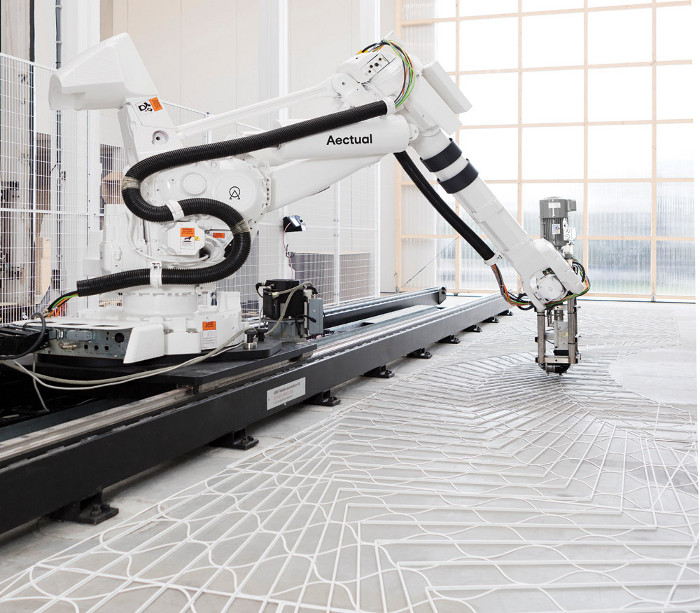Aectual CTO Jelle Feringa on robotics in architecture
Aectual CTO Jelle Feringa is pioneering the use of robotics in architecture. In this profile, FX finds his enthusiasm for the subject infectious

Words by Emily Martin
Dutch firm Aectual showcased some cutting-edge innovations at Clerkenwell Design Week. But to label them ‘surface design’ would be far too simplistic, for what is produced at Aectual pushes the boundaries of science and architecture towards a radical new approach.
The company works with a range of clients on largescale, bespoke, 3D-printed architectural products. These fall into a number of categories: floors, space dividers, facades and formwork. Each ‘provides limitless design possibilities in sustainable materials’, according to the company website.
 The firm can create tailor-made architectural products using bio-based and recycled materials. Aectual’s products fall into four categories: floors, space dividers, facades and finally formwork. Image credit: ILSE Leenders.
The firm can create tailor-made architectural products using bio-based and recycled materials. Aectual’s products fall into four categories: floors, space dividers, facades and finally formwork. Image credit: ILSE Leenders.
Visit its factory in Amsterdam and you’ll see hi-tech printers in action, which fall under the remit of CTO Jelle Feringa. He is somewhat of an expert in design and robotics, and meeting with him leaves a lasting impression.
‘Frankly, I’m an autodidact,’ begins Feringa. ‘That said, I’ve been developing a PhD thesis at the Hyperbody research group, at the Faculty of Architecture, at Delft University of Technology. This research led to a spin-off in Denmark, Odico formwork robotics, specialising in largescale, bespoke, formwork, for casting geometrically complex concrete elements.’

Not only is Feringa fiercely intelligent, he is also very passionate about his work, and it’s hard not to find his enthusiasm infectious. When he says, ‘You must come and see the factory in The Netherlands – it is a magnificent space!’, he is able to reignite a magical wonder in what for any design journalist is just another factory visit.
Having taught at the Bartlett’s Design for Manufacture programme in the first year of its inception, he still lectures and participates in reviews regularly. His work is helping to pioneer the use of robotics in architecture.
‘What is so thrilling about being involved in robotics and architecture is how incredibly multifaceted the work is,’ he says. ‘I enjoy the mathematics and focus involved in writing a piece of software, but also seeing the tangible results when developing new products, processes or materials. If the maths in your motion-planning isn’t spot on you’ll see this reflected in the pieces you’re fabricating.’
 The Nike store on London’s Oxford Street features an Aectual interior panel system
The Nike store on London’s Oxford Street features an Aectual interior panel system
Having helped develop the ‘means of production’, Aectual is able to create tailor-made architectural products using bio-based and recycled materials. But despite huge investment, in what Feringa calls ‘generative design software, XXL printers and print materials’, it nevertheless enables the creation of original products at incredible speeds. Take the Nike store on London’s Oxford Street, which features an Aectual interior panel system that builds on the aesthetic of Nike’s woven fabric. The product was realised from idea to installation in less than six weeks. And that positions the company very uniquely. Says Feringa: ‘I think a previous generation of architects have focused so thoroughly on the subjective side of the profession – developing ideas, concepts, new aesthetics and formal languages – there’s been an alienation of the delivery of architecture.’
He does credit previous attempts at developing a ‘new architectural language’, but says momentum was lost owing to cost. ‘What’s exciting now is that we’re in a considerably stronger position in delivering this new, evolving language with increasing confidence,’ he explains. ‘We are no longer pricing ourselves out of the market, but quite the opposite: becoming more competitive with every project that is delivered.’
 The Nike store on London’s Oxford Street features an Aectual interior panel system
The Nike store on London’s Oxford Street features an Aectual interior panel system
Another Aectual project – for the BMW Welt event venue in Munich, in collaboration with Spanish architect and designer Patricia Urquiola – showcases a spectacular interior floor design. It underscores the company’s approach of engaging with designers and pushing the product forward to develop momentum.
The kind of architectural products Feringa and his colleagues are developing explore a completely new business model for architecture, one that is set to excite future generations of architects.
‘[Currently] architecture is poorly distributed and I feel that a focus on product development is indispensable,’ he says. ‘Developing a portfolio of products fuelled by the possibilities offered by robotics, additive manufacturing, and the exciting new fabrication methods that have been emerging for over a quarter century is an exciting agenda.’












